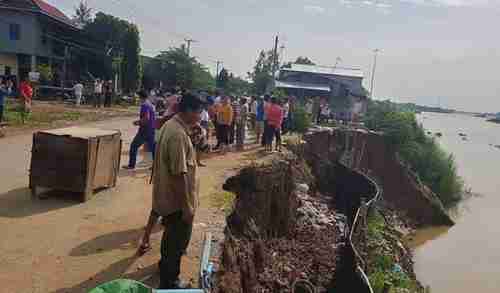This morning’s key headlines from GenerationalDynamics.com
- Cambodia bans all sales of sand to Singapore
- The world is running out of sand
Cambodia bans all sales of sand to Singapore

Cambodian villagers protest sand dredging after nine homes collapsed into the river (Khmer Times)
Cambodia’s Ministry of Mines and Energy has banned all sales and exports of sand to other countries. For years, the principal customer of Cambodia’s sand exports has been Singapore, which has used the sand to reclaim land along its coasts. Using land reclamation, Singapore has expanded its landmass by more than 20 percent since its independence in 1965. During the same period, Singapore’s population tripled.
The new decree, issued on July 10, bans all exports of “construction sand and mud sand” from southwestern Koh Kong province to overseas but stops short of outlawing domestic sales. Other southeast Asian countries – including Vietnam, Indonesia, and Malaysia – have implemented bans in the past.
Environmental groups have been pressing the government to stop the export of sand, saying the digging and dredging has had a serious impact on coastal ecosystems and surrounding land. In one Cambodian district where sand dredging had been taking place, nearly 200 people last month held a protest against the sand dredging. They called on authorities to take action after nine homes collapsed into the river, as a result of the dredging.
Cambodia had already suspended sand exports in November of last year, because of a corruption scandal. Singapore claims that it had imported 72.2 million tonnes of sand between 2007 and 2015, the Cambodian government officials said that only 16 million tonnes had been sent. In money terms, the UN said that Cambodia had exported $752 million in sand, but Cambodia claimed it was only $5 million worth of sand.
Environmental activists are skeptical that the new ban will be enforced. After Cambodia suspended sand exports in November of last year, illegal exports continued despite the order. Khmer Times and Khmer Times (12-June) and Radio Free Asia (2-Nov-2016) and AFP and Radio Free Asia (5-May)
The world is running out of sand
In 2014, the United Nations Environment Program concluded that:
Sand and gravel represent the highest volume of raw material used on earth after water. Their use greatly exceeds natural renewal rates. Moreover, the amount being mined is increasing exponentially, mainly as a result of rapid economic growth in Asia.
…
Negative effects on the environment are unequivocal and are occurring around the world. The problem is now so serious that the existence of river ecosystems is threatened in a number of locations.
Sand and gravel are used for land reclamation, as in the case of Singapore, but for a lot of other things as well. They are the main constituents in concrete and asphalt that are used in building constructions, roads, and many other structures. A typical American house requires more than two hundred tons of sand, gravel, and crushed stone for the foundation, basement, garage, and driveway, as well as the section of street in front of it. A mile long highway requires 38,000 tons.
In the last four years, China has used as much concrete as the United States in one century, according to Pascal Peduzzi, the author of the UN report quoted above. In India, sand is so scarce that markets for it are dominated by criminal “sand mafias.”
According to the UN report:
Five countries — China (58%), India (6.75%), the United States (2%), Brazil and Turkey — produce 70% of the world’s cement. However, cement demand by China has increased exponentially by 437.5% in 20 years, while use in the rest of the world increased by 59.8%. Each Chinese citizen is currently using 6.6 times more cement than a U.S. citizen. Demand continues to increase with new infrastructure and renewal of existing infrastructure (roads, bridges, dams, houses) — all dependent on the availability of aggregates.
UN’s Peduzzi says that Lake Poyang, for example, is China’s biggest freshwater lake but also its biggest source of sand, with estimates of over 230 million cubic meters of sand extracted each year. This is lowering the lake’s water level, potentially damaging surrounding wetlands and affecting the flow of nearby rivers, including the Yangtze.
According to Peduzzi, the exponentially growing demand for sand cannot continue without substantially harming the environment, and the world needs a “reporting mechanism at the global level which allows recording the amount of sand and gravels used by countries.” New Yorker (29-May) and UN Environment Program (PDF, 2014) and Nikkei
Related Articles
KEYS: Generational Dynamics, Cambodia, Koh Kong, Singapore, United Nations Environment Program, Pascal Peduzzi, China, Lake Poyang, India
Permanent web link to this article
Receive daily World View columns by e-mail

COMMENTS
Please let us know if you're having issues with commenting.